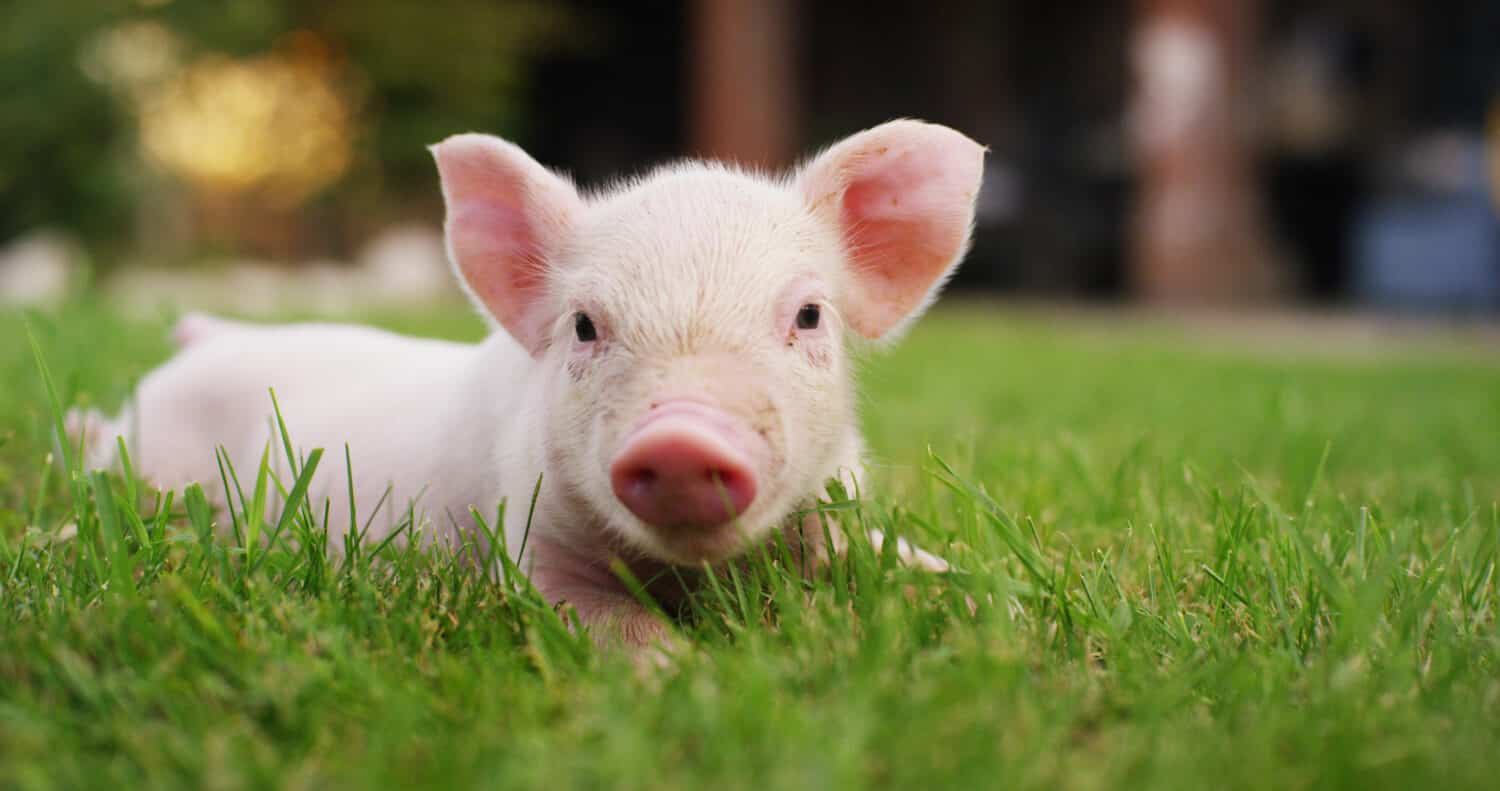This article will discuss the difference between chickens and pigs. In a nutshell, pigs are even-toed and hoofed mammals. They also go by the name swine or hogs. A chicken is a bird, but if you dig further, you will discover that chickens are actually a domesticated red junglefowl species. This post will jump into what that is later on.
The differences do not stop there. Pigs and chickens vary in many ways, including their history, what they eat, and their many quirks.
When you hear someone mention pigs, images of Wilbur may appear in your mind. The sweet, innocent cartoon pig who wanted nothing more than to live a good life.
Maybe you hear the chicken dance play in your head when thinking about chickens. The truth is animals of all kinds are everywhere. They are in nursery rhymes, television shows, songs, and in most families on our tables.
Sometimes we give very little thought to where our food comes from. If you are a meat eater, you may never think about the differences between the types of animals that co-exist with us. However, knowing exactly where our meat comes from, and the differences between each animal can be good.
- The must-have convenient reference guide for every home cook!
- Includes more than 8,000 substitutions for ingredients, cookware, and techniques.
- Save time and money on by avoiding trips to grab that "missing" ingredient you don't really need.
What are the Main Differences Between Chickens and Pigs?
Chickens and pigs can be fun to watch, especially for children. Have you ever seen a young child's eyes light up when they explore chickens taking a dust bath or see a pig rolling around in the mud? Aside from their preferred habits, chickens and pigs differ in other ways. Let's explore those ways below.
History of Pigs
Domesticated pigs have been around for thousands upon thousands of years. It is thought that the first pigs were domesticated in 8500 BC. From there they began their travels to various places worldwide. It is actually said that a pig was the first animal to be domesticated.
A sus domesticus is the scientific name of a pig. They are descendants of the wild boar. Their scientific name is Sus Scrofa.
History of Chickens
Among those who study chickens is an ongoing debate about the true scientific identity of the domestic chicken. Many believe chickens to be domesticated from the wild red jungle fowl. The scientific name is Gallus gallus. However, others still believe this fowl has a subspecies, resulting in the chicken, whose scientific name is G. gallus domesticus.
Like pigs, chickens go by different names. On the male side, you have the cocks, roosters, and cockerels. On the female side, there are hens and pullets. Further still, chickens who are specifically going to be butchered for their meat have their own name: capons.
The domestication of the chicken took place around 10,000 years ago. They have been a convenient and important part of providing meat and eggs to eat for thousands of years. Not to mention, they are fun to watch!
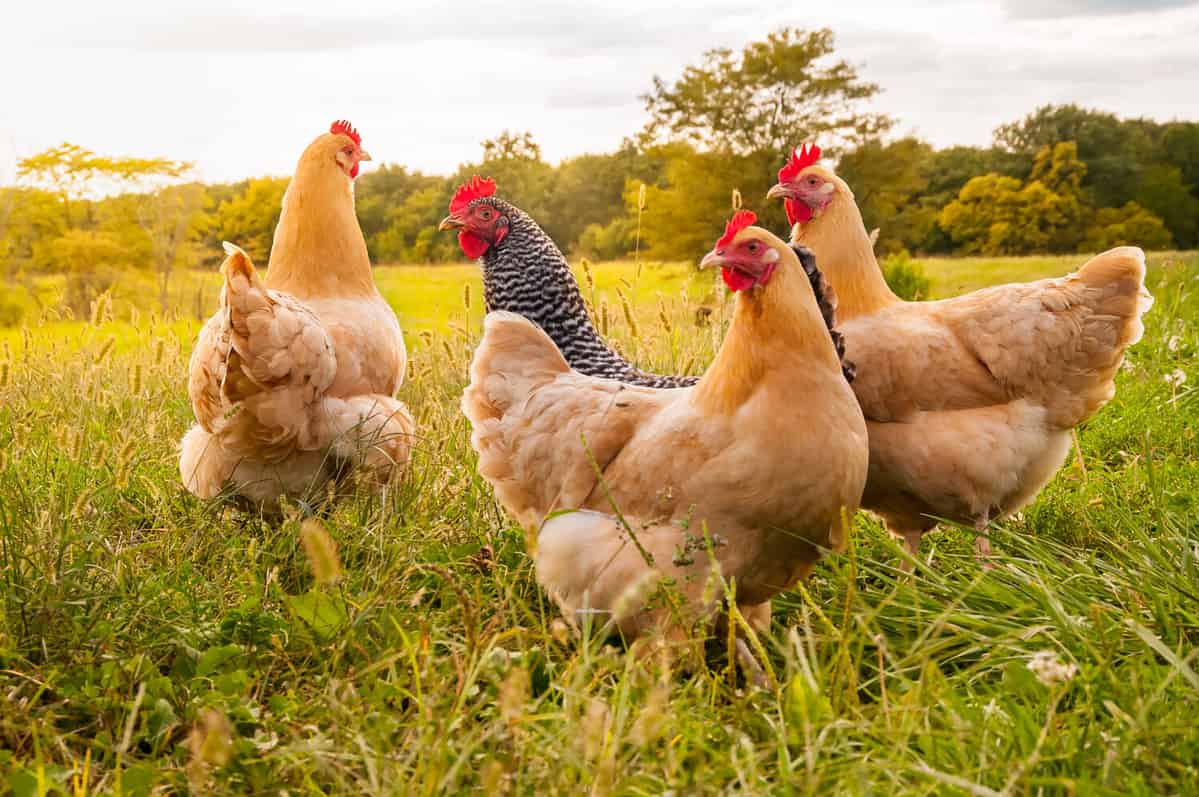
Chickens are social animals who enjoy their space and are quite nosey!
©Moonborne/Shutterstock.com
Preferred Habits of Pigs
Pigs are very intelligent and intuitive animals. The personality of Wilbur from Charlotte's Web paints an endearing picture of a lovable pig. The intuition and intelligence that Wilbur displayed are not far from the truth. Pigs have the ability to learn very quickly. Their hearing and their smell are excellent.
Pigs want to be around other animals that they know. They can get aggressive when they are with animals they may not know.
With images of pigs rolling around in the mud and the expression “This room is a pigsty,” one may automatically assume pigs are dirty. However, did you know pigs are truly pretty clean animals? They like to keep their living spaces clean, using the bathroom in a different area.
Preferred Habits of Chickens
Like pigs, the habits of chickens are also fascinating.
Chickens are very picky when it comes to choosing a mate. Health, strength, looks, and hunting are all factors for female hens when they are looking to mate.
Have you ever seen a chicken scratch the ground? This is a very common behavior. It means several different things. Chickens scratch for foraging, creating a nest, or even dust bathing.
Chickens also love to roam! They are social and are honestly pretty nosey. They want to see what is going on around them. Getting out and about is good for them because they can become stressed if stuck inside a pen with other chickens for long periods. Even humans become claustrophobic; it makes sense that animals would too!
What do Pigs Eat?
Pigs eat corn, soybeans, and grains. This diet allows them to get the protein they need. Sometimes, a farmer will also add a supplement. However, pigs are omnivores; therefore, they will most likely eat whatever you put in front of them.
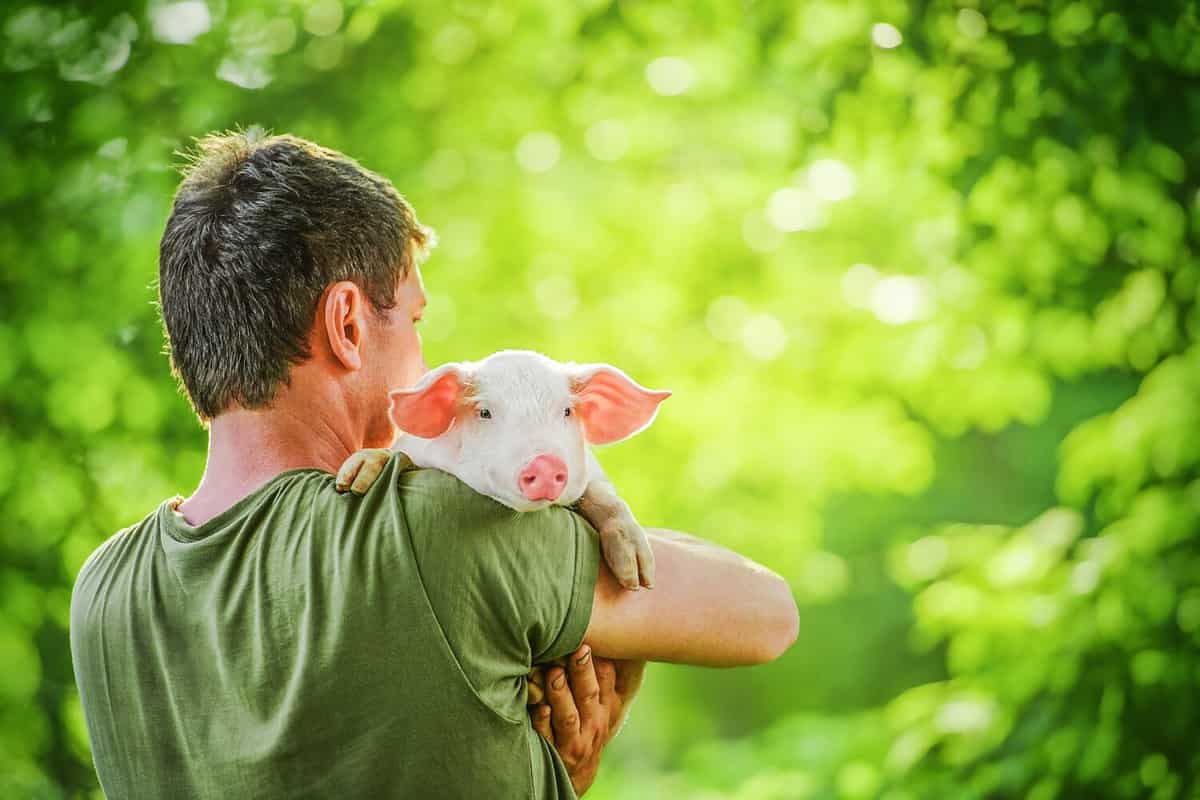
Pigs are very social and intelligent animals. They enjoy being around familiar people and animals.
©The Len/Shutterstock.com
What do Chickens Eat?
Chickens are omnivores and love eating grains, vegetables, and fruits.
Which One is Easier to Care For?
The smaller chicken is a bit easier when raising farm animals than a pig. It is lower maintenance and isn't as susceptible to becoming as ill.
Chickens do not need much, and their small nature makes them easier to care for.
Fun Facts About Chickens
One fun fact about chickens is that they have great memories! They can recognize humans, also.
- The must-have convenient reference guide for every home cook!
- Includes more than 8,000 substitutions for ingredients, cookware, and techniques.
- Save time and money on by avoiding trips to grab that "missing" ingredient you don't really need.
Did you know that chickens also purr? This is so interesting; many people go their whole lives without realizing it.
Many think that chickens can't fly. This is honestly not true. Chickens can try to fly; it just doesn't get them very far.
One last fun fact, chickens don't take water baths. They prefer dust baths. The reason for this is because their oil gland is on their back. Their oil is great for keeping their feathers waterproof. However, the oil needs cleaning off every once in a while. So, chickens will kick up dirt, spread it around, and get it all over their bodies. Then the chicken shakes the dust off. This is the perfect bath for chickens!
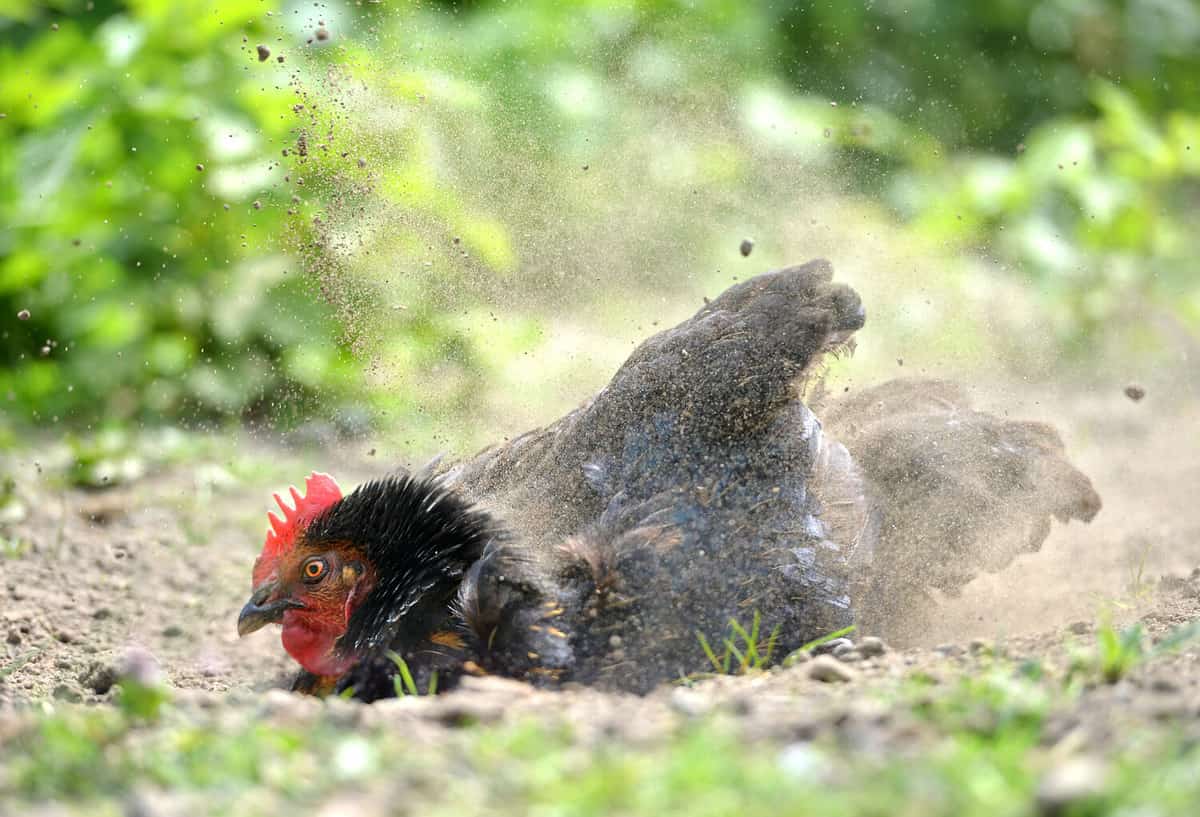
A dust bath is an important process that helps keep chickens healthy.
©Peter Cripps/Shutterstock.com
Fun Facts About Pigs
Pigs are social animals. They enjoy the company of animals and people. They can also develop different noises and calls to communicate.
Another fun fact, the tail of a pig may be able to tell you how they are feeling. When a pig is happy, their tails will curl. However, if the pig feels stressed, it tucks its tail between its legs.
The reason for the mud rolling is to keep cool, not because they enjoy being dirty! They do not have sweat glands.
Another fun fact, Mom pigs will sing to their babies!
One Last Note
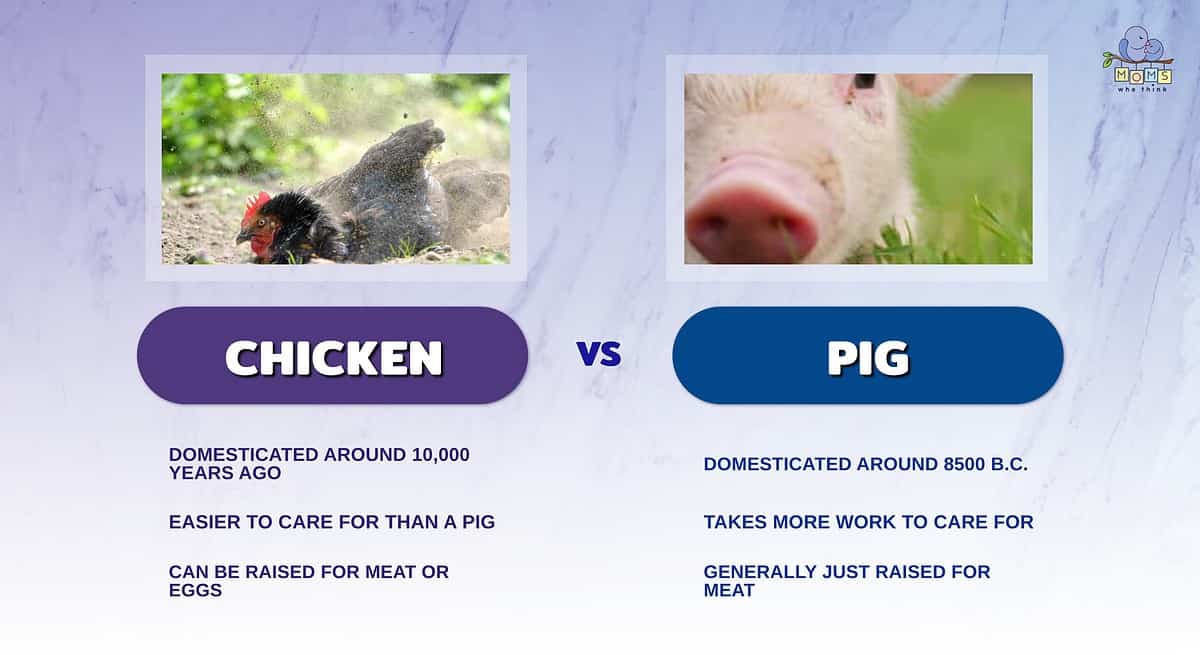
- Chickens and pigs were first domesticated thousands of years ago. Some believe that the pig was the first domesticated animal.
- Since they're smaller, chickens are easier to care for than pigs. Both animals require time, money, and space, though.
- Chickens are raised for meat and eggs, while pigs are generally only raised for meat.
Pigs and chickens are fun farm animals that children and adults enjoy seeing. They are very popular animals that are raised for their meat. Chickens also provide us with eggs that can be great for our health.
The two have a fantastic history and fun facts regardless of what animal you love. For example, did you know that pigs are actually clean animals? What about chickens becoming stressed if they are in close courters? It can be easy to think of animals as just another thing we eat. However, it is pretty clear that many animals also possess incredible intelligence and social skills. In fact, the intelligence of a pig has been described as that of a small toddler!
Chickens and pigs are both unique and amazing animals with extraordinary qualities. Which one do you prefer to watch?
When it comes to eating, do you prefer chicken or pork? If pork is your preference, take a look at this recipe:
PrintPork Tenders with Honey Mustard Sauce
Ingredients
1 quart peanut or vegetable oil
1 1/2 cups flour
1 1/2 cups cornstarch
2 teaspoons Lawry’s Seasoned Salt
1 teaspoon ground black pepper (optional)
2 eggs, well beaten
6 Tablespoons milk
3/4 package Chicken in a Biskit crackers, crushed, or other seasoned crackers
8 4-oz boneless center cut pork chops/pork loin slices, tenderized *cut these into 3-4 strips per 4 oz. loin slice, lengthwise
additional seasoned salt or sea salt for sprinkling post-frying
For the Honey Mustard Dipping Sauce:
2/3 cup honey
3 tbsp yellow mustard
1 tbsp Dijon mustard
Instructions
1. Heat oil to 350 degrees in a large, heavy-bottomed skillet.
2. Combine flour and cornstarch in a large glass baking dish.
3. Add Lawry’s and pepper. In a separate baking dish add beaten eggs and milk, mix together.
4. In a third baking dish, add crushed crackers plus 5 TBSP of flour/cornstarch mixture. Mix well.
5. Dredge each piece of tenderized pork in flour, shake excess.
6. Dip in egg/milk mixture, shake excess.
7. Dredge in cracker crumb mixture.
8. Place on clean plate and repeat with other pieces until complete.
9. When ready to fry, be sure oil is 350 degrees.
10. Fry 4-6 pieces or 1 large piece of meat at a time in 350 degree oil, for 2 minutes and until golden brown. Use a meat thermometer to test doneness, at least 145 degrees.
11. Remove to paper towel lined plate. Serve immediately with honey mustard dipping sauce.
Directions for the Honey Mustard Dipping Sauce:
1. Combine honey and mustard in a bowl. Stir well. Serve at room temperature.
Notes
This is the reason for the 50/50 cornstarch coating in this recipe. When it comes to coating chicken or pork for cooking — particularly for fried — flour is the common go-to, but if you want very crisp, crunchy skin, cornstarch is the better option. Cornstarch is a pure starch often used as a thickening agent for sauces and soups, and is commonly used in Asian cooking for stir-fries. When used to fry chicken or pork , it helps with browning and creates a super crisp crust that seals in the juices of the chicken or pork.
Comparison Posts
- Turkey Eggs vs. Chicken Eggs: Exploring the Differences
- Chicken Francese vs. Piccata: Texture, Taste, and Preparation Differences
- Chicken Thighs vs Drumsticks: Similarities and Differences Of The Two
- Pork vs. Beef: The Difference Between Two Of The Most Popular Meats
- Pork Belly vs. Bacon: One Location, Two Very Different Types Of Meat
The image featured at the top of this post is ©Kitreel/Shutterstock.com
